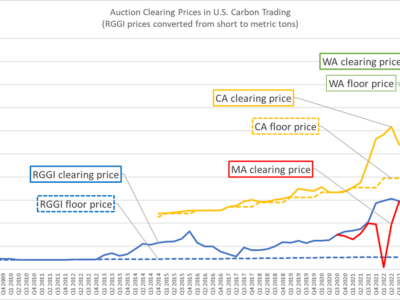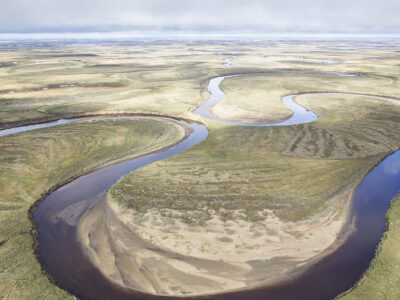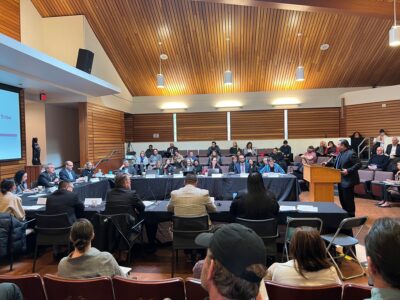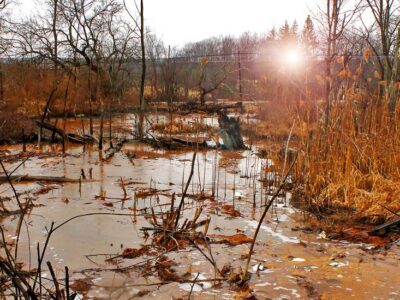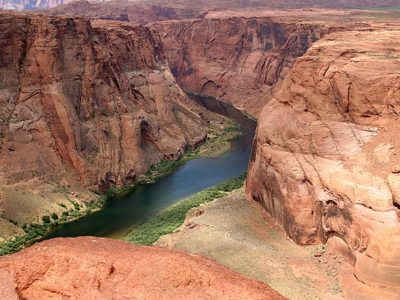Cap and Trade Heats Up—For Better or Worse
Prices are high and markets are proliferating as program designers lean away from the more controversial elements of carbon trading.
This past year has been big for cap-and-trade-style systems, and that momentum looks like it’s continuing in 2023. Recently, we’ve seen new programs start up in Oregon and Washington, a proposal in New York State for new carbon markets, and sustained high prices in existing programs in California and the Northeast. Although these programs differ in their details, they all attempt to reduce greenhouse-gas emissions cost-effectively by creating a market for permissions...
CONTINUE READINGDeregulation, Normal Accidents, and the Airborne Toxic Event
What can we learn from the East Palestine train wreck?
Source: Wikimedia Commons The East Palestine train derailment is the story that won’t go away. Images of enraged residents shouting at company executives and government officials about the inadequacy of the response remind us all that across our vast industrial economy accidents of one sort or another are always waiting to happen while private firms and the agencies that are supposed to regulate them are too often asleep at the switch. The train was carryin...
CONTINUE READINGDid Biden have to approve the Willow oil project?
ConocoPhillips has existing lease rights. But the Biden administration had tools to curtail those rights to limit harms.
Although the Biden administration has approved the Willow oil drilling project on Alaska's North Slope—the largest proposed oil drilling on U.S. public land in several decades—the legal questions are far from settled. Much of the media coverage so far has focused on the political dynamics driving the decision (as noted with some alarm here and here) and devoted less attention to the legal dynamics. So, is there merit to the Biden administration’s claim tha...
CONTINUE READINGTribal Energy Sovereignty in California
California's energy agencies hold joint hearing with Tribal governments.
On Thursday, March 2, 2023, California’s principal energy agencies – the California Energy Commission (CEC) and the California Public Utilities Commission (CPUC) – held a first-of-its-kind, joint en banc hearing at Cal Poly Humboldt with Tribal government leaders and all 10 commissioners of the CEC and CPUC. In a world where on-the-ground collaboration between governments to address essential questions like climate change and energy security seem too few and far be...
CONTINUE READINGCutting 290,000 Tons of Water Pollution a Year, One Coal Plant at a Time
Coal is a dirty fuel. It's not just air pollution or climate change.
EPA proposed new regulations next week to reduce the water pollution impacts of coal-fired power plants. As EPA regulations go, these count as fairly minor. They got a bit of news coverage in coal country and industry publications. But they will eliminate the discharge of thousands of tons of pollutants, including a lot of metals that pose health problems. The rulemaking illustrates the highly technical nature of regulations and the lawless nature of Trump’s EPA. I...
CONTINUE READINGConnecting New Housing to Needed Energy Service
Why is PG&E taking so long to provide energy to new homes?
An article in the San Francisco Chronicle highlights an apparent pattern of delays on the part of the Pacific Gas and Electric Company (PG&E) in providing energy service to new homes. At a time when policy makers on all levels are pushing for the construction of much-needed housing, the Chron reports that many new homes sit empty for months before PG&E can get around to turning on the power. How can this be? PG&E suggests that its efforts relate...
CONTINUE READINGTop 5 Climate Reasons To Reduce Driving, Even With Electric Vehicles
Sprawl and EVs still have significant carbon costs
California and other jurisdictions have been moving to reduce vehicle miles traveled (VMT) as a climate solution. Yet some pro-sprawl interests question whether this is necessary, given the advent of electric vehicles. It's fair to ask: if all vehicles are "zero emission," do we really need to care any more about how much driving we do, in terms of the climate impact? The answer is unequivocally yes, and here are the top five reasons: Gas cars will be w...
CONTINUE READING“Major Questions” for Texas (and for the Environment)
Defending clean car regulations and tracking judicial decision-making
Last June, the Supreme Court formally unveiled the “major questions” doctrine in the landmark environmental case West Virginia v. EPA. In rejecting EPA’s plan to regulate greenhouse gas emissions from existing power plants under Section 111(d) of the Clean Air Act, the Court stated that “agency decisions of vast economic and political significance” (i.e., those that pose “major questions”) must be made “pursuant to a clear delegation” from Congress. ...
CONTINUE READINGClimate Policy’s “Plan B”
As the initial top-down approach failed, a new approach to climate policy crystalized.
My last blog post told the story of the original top-down approach to climate policy. It was supposed to feature binding restrictions on carbon emissions in a global treaty and federal legislation. By 2012, it was plain that neither half of this "Plan A" strategy was in the offing. Building on trends that had begun in the previous decade, however, a new bottom-up approach took hold. Rather than waiting for global agreement, as many policy analysts had advised, individ...
CONTINUE READINGWhy Can’t We All Get Along On The Colorado River?
Maybe It Is Time For the Interior Secretary To Settle The Issue -- And For Newspapers To Get Rid Of Op-Eds
Well, this was intriguing. An op-ed from ran with this evocative title: California and its neighbors are at an impasse over the Colorado River. Here’s a way forward. Its author was Eric Kuhn, a former general manager of the Colorado River Water Conservation District and a co-author of “Science Be Dammed: How Ignoring Inconvenient Science Drained the Colorado River.” I should read this, I thought: given how completely intractable the River has been, may...
CONTINUE READING



